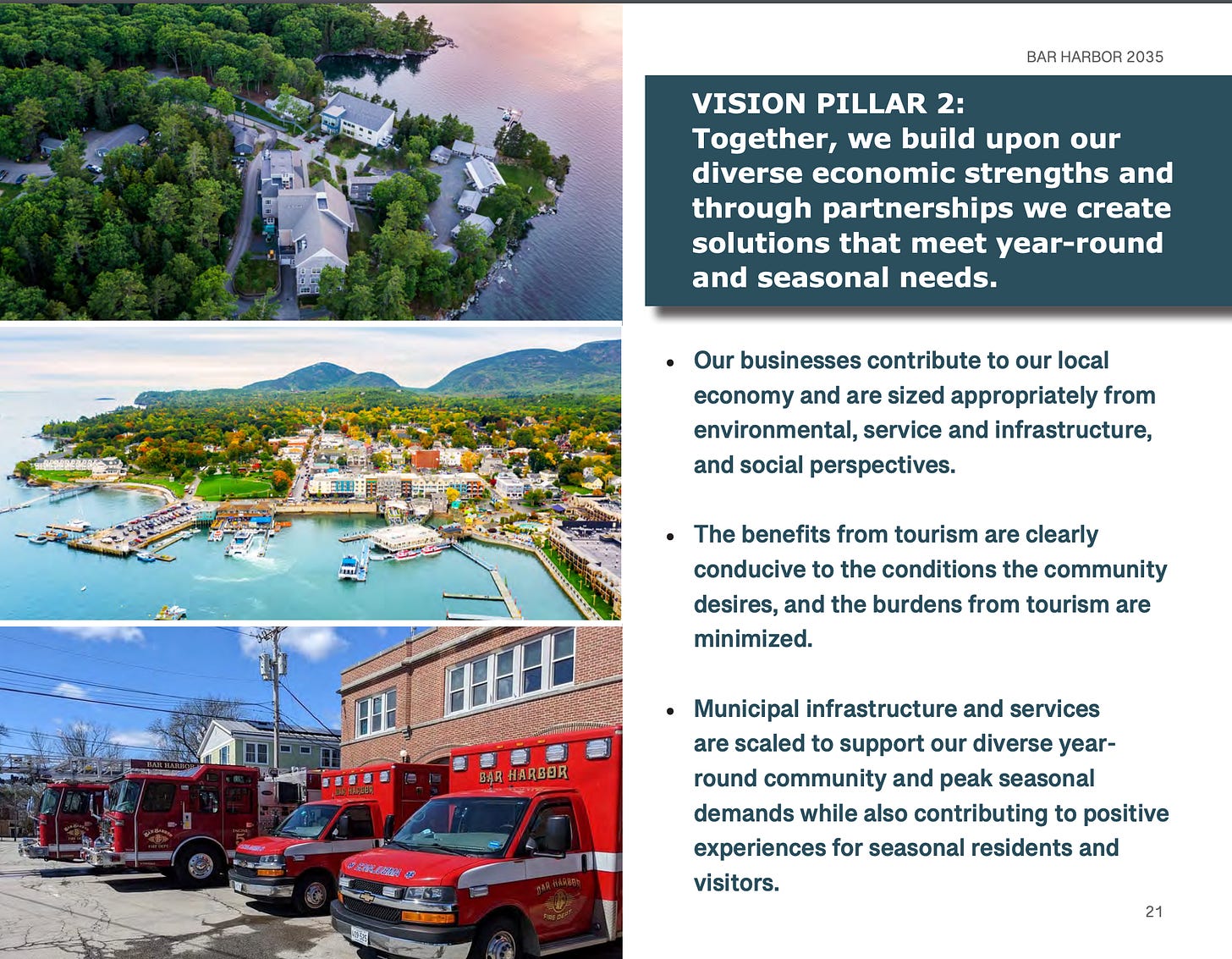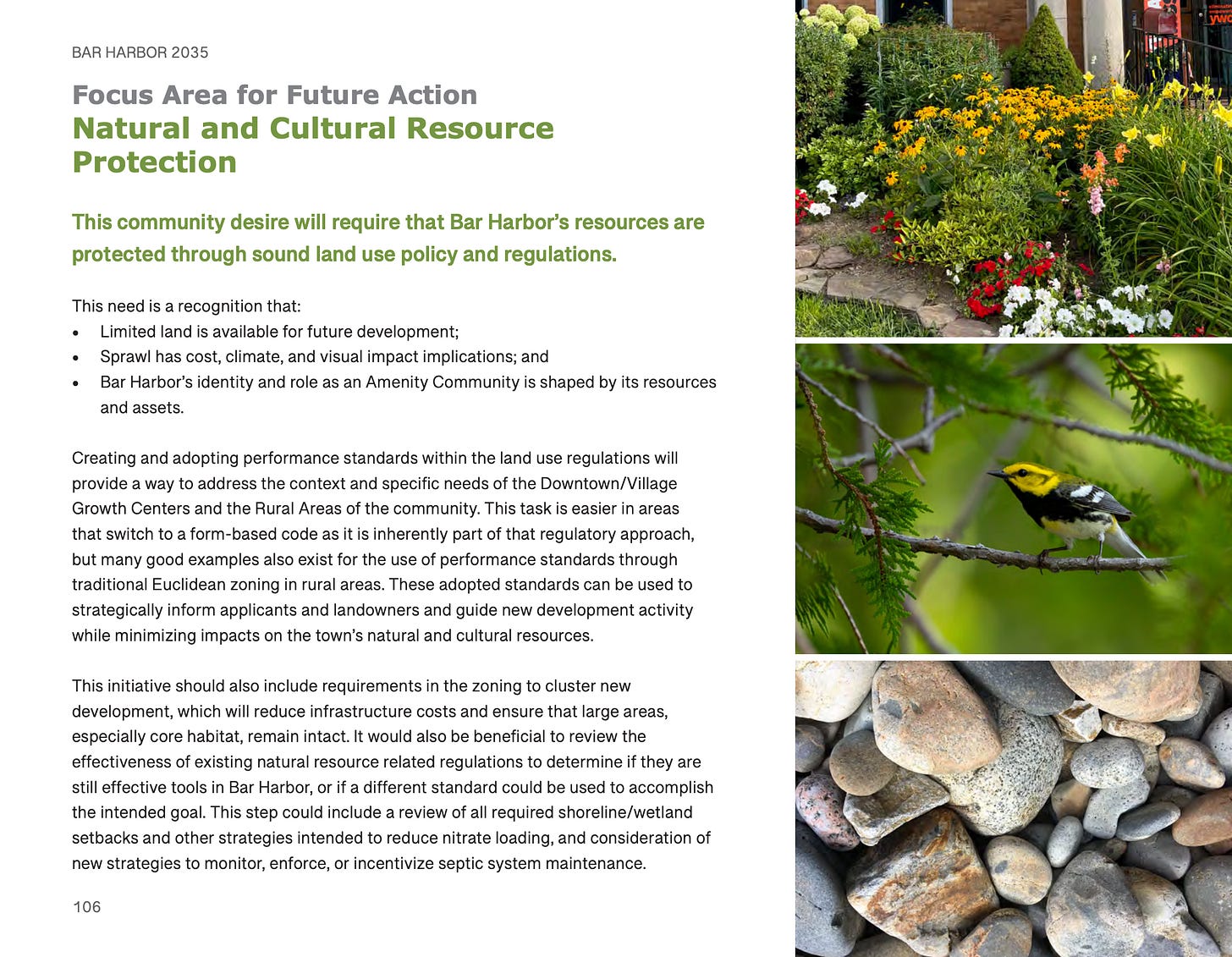Bar Harbor's Proposed Comprehensive Plan Tweaked and Unveiled
The Bar Harbor Story is generously sponsored by The Witham Family Hotels Charitable Fund.
BAR HARBOR—The draft Bar Harbor Comprehensive Plan has been sent to the state for review and to the town’s Comprehensive Planning Committee for review and tweaking.
The plan came after a hiatus since March as the plan was shaped into its current form—a 100-plus page document with multiple photos and graphs.
“It’s nice to get the band back together,” said the Chair Greg Cox.
Bar Harbor Planning Director Michele Gagnon said they hope to have state comments back by December 2024.
Gagnon said that they will give an October 1 update to the Town Council. There will be some more outreach to department heads, boards, and committees to see if there are issues they want to bring to members’ attention.
”We’re going to go out there and we’re going to present the plan,” Gagnon said.
In January 2025 there will be a last round of edits and a public hearing in March 2025 and the plan will be placed on the ballot in June 2025 for the voters.
Steve Whitman of Resilience Planning and Design, the firm that developed the plan with the town, said that the plan was assembled using materials the public and committee shaped and formed over the last few years. In early August, it was proofread. Those edits are now back and were presented to the committee this week.
“What we’re hoping to get a sense of tonight is if the plan hits the mark,” Whitman said. Does it reflect the direction they want? It’s not going to provide every answer to every issue, but instead be a baseline and start, he said. “It’s your plan. It needs to reflect what you want in there.”
“Everybody has a different opinion,” Cox said about the creation and tweaking of the plan, and there were concerns about the granularity of some sections and if it’s as detailed as it should be. The document is supposed to provide general guidance but not be so detailed that it becomes out of date quickly, he said.
WHAT THE PLAN DOES
The plan is meant to create a vision and guide for actions for Bar Harbor’s future. It has six sections including a glossary and an appendix. The other sections deal with the plan’s theme and frameworks, and implementation, and explain Bar Harbor today and tomorrow.
WHAT ARE THE ISSUES THE PLAN MENTIONS
There are multiple issues that shaped the plan’s direction, including:
“The impacts of both housing and labor shortages across Mount Desert Island.
“The limited land available for future development, which influences how Bar Harbor meets its future housing, economic, and infrastructure needs.
“The cost implications of sprawling development, which is prevalent in portions of town.
“Infrastructure investments that are needed to support future development activity.
“The impacts of over-tourism and over-crowding throughout the community.
“The lack of revenue, as a small community, to meet the expectations and needs of residents and visitors alike.”
The draft plan also mentions that more than 50% of Bar Harbor’s land is in conservation. That, along with wetlands and limited water and sewer infrastructure, constrains development, be it for housing or commercial uses.
It also mentions tourism as an economic driver and the estimated 1.3 million visitors to Acadia National Park.
“While the tourism sector generates jobs and income (through parking and cruise ship fees) that help support some municipal services, it also results in additional costs to the community,” the report reads. “The tourism season is also lengthening on either end of the summer season and the needs of the workforce are changing. The growth and success of the tourism sector and noted impacts are generating tensions within the community and prompting interest in coordinated and collaborative tourism management efforts. Just as natural resource protection and housing development can appear to be at odds with each other and need to be balanced, Bar Harbor’s diverse economy and tourism management need thoughtful consideration and balance as well.”
It also calls out the town for being in an amenity trap, where people come into a successful destination community, which results in economic opportunities, but then has drawbacks such as infrastructure pressure, housing costs increase, and loss of long-term, year-round residents, and the town’s fiscal health.
VISIONS, PILLARS, AND FUTURE LAND USE STRATEGY
The proposed plan also includes vision pillars that create a collective vision of what the Bar Harbor community will be in 2035.
The plan details a future land use strategy, writing, “Bar Harbor’s Future Land Use Strategy focuses on minimizing sprawl and the fragmentation of the remaining undeveloped rural areas. As much as possible, it focuses future development near existing developed areas and municipal services to ensure the future growth contributes positively to the overall community. There is a strong desire within Bar Harbor for rural areas to appear and be treated differently than mixed-use development areas.”
It shows focus areas of Bar Harbor proper as well as Hulls Cove and Town Hill.
POTENTIAL CHANGES AND EDITS TO THE DRAFT
The phrase “and is intended to be a living document” was questioned for being “wishy washy” language by some committee members.
Discussion also focused on downtown and creating a downtown mixed-use corridor that could protect and promote residential use rather than lodging and other commercial endeavors.
“To me it would be more appropriate to look at those commercial uses we have in there now,” committee member Jim Mahoney said. He didn’t want it implied that the plan could leak more into residential areas of downtown proper.
Committee member Misha Mytar agreed that the value of the downtown center is being where a lot of people are housed and that it should be there right up front in the plan rather than just interspersed in the plan. Committee member Elisa Chessler said it’s important to mention the need to protect residential areas in downtown. There was some discussion about how forcing development to the periphery and potentially displacing people contributes to sprawl and/or housing issues.
Committee member David Woodside said he felt that the committee has identified a need for housing and then may be systematically eliminating all the possible solutions for that housing.
They also questioned some of the photos used, including one of a cruise ship on the tourism management page and, in general, if the images match the story.
All images from the draft plan.
LINKS TO LEARN MORE
https://headwaterseconomics.org/wp-content/uploads/2023HE-Amenity-Report-R3b-LOWRES.pdf
https://www.barharbormaine.gov/AgendaCenter/ViewFile/Agenda/_09182024-3483
https://www.barharbormaine.gov/517/Comprehensive-Planning-Committee
https://www.maine.gov/dacf/municipalplanning/comp_plans/Bar_Harbor_2024.pdf
UPCOMING SAFETY PLAN DISCUSSIONS
If you’d like to donate to help support us, you can, but no pressure! Just click here.
If you’d like to sponsor the Bar Harbor Story, you can! Learn more here.















